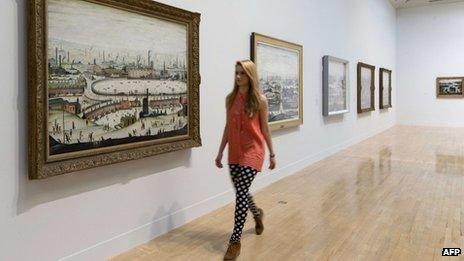Lowry will always split art world, says Tate curator
- Published
David Sillito explores how Lowry was influenced by his surroundings
The works of LS Lowry will continue to divide opinion within the art establishment, predicts the co-curator of a major new Tate exhibition.
"He became a football in a certain kind of culture wars - and I think that will go on being the case," said Professor Tim Clark.
Lowry and the Painting of Modern Life opens at Tate Britain on Wednesday.
The show is the first to be held by a public institution in London since Lowry's death in 1976.
Born in 1887, Lowry is best known for his paintings of the industrial landscapes of the north of England.
Many works depict the factories and terraced houses - and their working class inhabitants - around Salford and Pendlebury where Lowry lived and worked.
"He is not an artist who fits into the Home Counties, Eton and Oxbridge view of England and Englishness," said Professor Clark, speaking at a preview of the Tate show on Monday.

Two of Lowry's Industrial Landscape paintings from the 1950s on display at Tate Britain
"He is not a subscriber to the cult of the countryside, country manors or the ambiguity or fatality of Empire. His subject is industry and the form of life that it made.
"It puts him outside things - it makes him very hard for the actual cultural elite of England to take seriously."
The exhibition, co-curated by art historians Clark and Anne Wagner of the University of California, features more than 90 works - including loans from public and private lenders.
Highlights include Ancoats Hospital Outpatients Hall (1952), painted in the early years of the NHS, and The Cripples (1949), which shows people disabled by war and illness.
The paintings include the Tate's own Coming Out of School (1927), The Pond (1950), Industrial Landscape (1955) and Hillside in Wales (1962).
The Lowry exhibition comes after critics from the art world called on Tate to show its collection of paintings or put them up for sale.
Some had questioned, external whether the gallery on London's Millbank had purposely not shown the Manchester artist's work because he was "too northern".
Speaking on Monday, Tate Britain director Penelope Curtis said the Lowry exhibition was for "believers and also for cynics".
"What we'd like to think is this show will delight people who love Lowry, but also open the eyes to those who thought that Lowry was not part of mainstream painting," she said.
The exhibition also explores Lowry's connections with French art and shows his work alongside French-themed paintings of Vincent van Gogh and Camille Pissarro.
The French impressionist, Adolphe Valette, taught Lowry in Manchester for many years.
"The myth says Lowry's an isolated weirdo completely off on his own," said Professor Clark. "Actually he very early on decided he was more likely to get sympathetic attention in Paris than in London."
He added: "Lowry's a very English artist indeed, but in order to have the confidence to take on the industrial scene he built on his understanding of the French painting of modern life."
Hidden painting
The Tate revealed on Monday that a little-known painting on the back of another work at the exhibition shed new light on the way Lowry would revisit and refine his favourite scenes over the years.
The unnamed painting on the wooden panel behind The Mission Room (1937) is an earlier version of two works featured in the exhibition: Our Town (1941) and A Town Square (1928).
"What this tells us is that Lowry was perfecting and developing his compositions with great care," Professor Wagner told the BBC.
"He is possessed with certain compositions throughout the years - he can't get them out of his mind. It's not that he had a paucity of invention, but that these are the works he wants to depict."

The Pond (left) is one of Lowry's large urban panoramas on display
The final room of the exhibition brings together, for the first time, seven large-scale panoramas of northern industrial landscapes and the Welsh mining valleys.
"They represent a step up in style and a move forward to a deliberate effort to lay hold of this stage industrial society as it was passing away," said Professor Clark.
"The paintings do have a valedictory, memorialising tone, though I don't think they are relentlessly glum and gloomy," he added.
Lowry and the Painting of Modern Life is at Tate Britain from 26 June - 20 October.
- Published24 June 2013
- Published1 June 2013
- Published18 April 2011
- Published17 November 2011